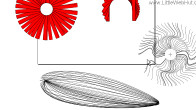

You just can’t see them because they’re behind this 3-D object. The Interpolate menu likes to stay open, so once you get this result, you can click the Close button.Ĭool, right? And even cooler: the original two text objects are still there. I’m going to try out 50 here.Ĭlick the Apply button, and this will happen. So keep it lower if you can under 100 should usually work for everything. For now, just know that the higher the number, the more work your computer and Inkscape will need to do. You’ll want the Method to be set to 1 (sometimes it starts you with 2 as a default).Īs for the steps: I’m going to discuss in a minute what that number means. There’s a lot of weird-looking stuff in here, but there are really only two fields we need to worry about: Interpolation Steps and Interpolation Method. Select both text objects and go to Extensions > Generate from Path > Interpolate. Now make that lower layer black again (or whatever color the front layer is we just want them to both be the same color). Just in case you decide later that you want your 3-D effect to be a little heavier or lighter, having this copy means you can skip all of the previous steps and start from here. Whatever rocks your socks here!Īfter you have them where you want them, this is a perfect spot to make a backup copy of these layers and tuck them away at the bottom of your artboard, or on another layer. You may want it closer in to the top layer than I have it you may want it farther away. Now, move the bottom layer around under the top layer until it sits where you want it. (You just need it to be something distinctly different enough from the top color so you can see what you’re doing in the next step. Move the one on the top, and recolor the one on the bottom any color you like. Now you’ll have two copies of the exact same thing, one stacked on top of the other. We’re going to be taxing Inkscape a little bit, so we want to do that with as few objects as possible. This will recombine the individual letters into one object. Now, select all of your letters and go to Path > Union. I feel like my A is a little bit too far from my O, so I’ve selected the A individually and nudged it to the left using my left arrow key. If there are any spacing adjustments you want to do, now’s the time. (Doing Object to Path automatically groups everything together.) Ungroup by using Object > Ungroup. Next up, you’ll want to ungroup the letters.

The first step is using Path > Object to Path. When you get the text the size you want, then it’s time to transform it from editable text into a vector object. (I also like WHOA because it has straight lines, angled lines, and curved lines. So hopefully, that should cover almost all of you.īecause this is areally cool technique, I’ve chosen the word WHOA. But why limit yourself to the few 3-D fonts out there, when you can create your own 3-D effect with any font?Īs is my habit lately, I’ll be doing this tutorial in good ol’ Inkscape, primarily because it’s free, and there are versions for Mac, PC, and Linux. I’ve seen a few requests lately for a 3-D font.


 0 kommentar(er)
0 kommentar(er)
